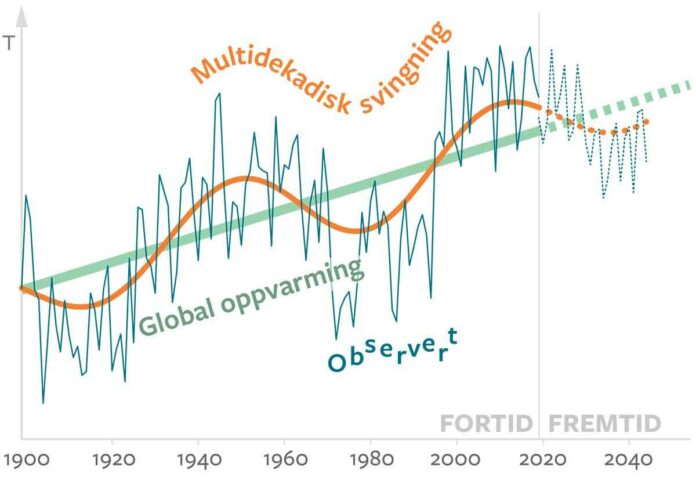Sea surface temperatures in the North Atlantic have fluctuated over several decades in the last century. These oscillations have not only occurred in the ocean. Corresponding changes in the Arctic sea ice cover, ocean currents and air up to the stratosphere have been observed.
The variations in the Northern Hemisphere winter are large enough to affect global temperatures. Some decades are significantly warmer than others.
This oscillation can be linked to a pause in global warming from the 1950s to the 1970s. It was followed by an increase from the 1980s to the 2000s. We are now entering a new period in which conditions in the North Atlantic should make it colder.
“The oscillations can temporarily dampen anthropogenic warming. But they cannot restore the climate of the 1950s, 1960s and 1970s,” Nour-Eddine Omrani says.
Omrani, a researcher at the Bjerknes Center and the University of Bergen, was the lead author of a paper on the mechanism underlying North Atlantic oscillations. Researchers from Germany, Italy, and the United States collaborated on the study.
The research was published in the journal npj Climate and Atmospheric Science.
Omrani now warns against misinterpretation of their findings. A slower rate of temperature rise in the coming years does not imply that global warming has slowed.
Climate change warms both the cold and warm phases of the oscillation. Less sea ice will disappear during cold phases than during warm phases. But in either case, more sea ice will melt now than fifty years ago.
Temperatures will rise once more
“The next multidecadal warming will begin at a higher level. It resulted in unprecedented warming and associated extremes,” Nour-Eddine Omrani predicts.
He hopes that we will make good use of the coming years.
The current and anticipated hiatus provides time to develop technical, political and economic solutions before the next accelerated global warming.
Oscillations improve climate predictability
A recent study found that the North Atlantic oscillation is reasonably predictable. It allowed practical applications.
Oscillations like the one in the North Atlantic allow us to forecast weather and climate for the coming seasons, years and decades. Another example is temperature variations in the tropical Pacific Ocean, which shift between El Nios and La Nias.
The accuracy of such predictions is dependent on understanding the mechanisms underlying the variations and as well as how the ocean and atmosphere are affected. This is a newer research area that combines global warming and variations on shorter time scales.
“Without long-term anthropogenic trends, the current and projected near-future climate evolution closely resembles the colder conditions seen in the 1950s and 1970s. Climate change makes the current and projected climates significantly warmer” Nour-Eddine Omrani concurs.
More information: Nour-Eddine Omrani et al, Coupled stratosphere-troposphere-Atlantic multidecadal oscillation and its importance for near-future climate projection, npj Climate and Atmospheric Science (2022). DOI: 10.1038/s41612-022-00275-1

